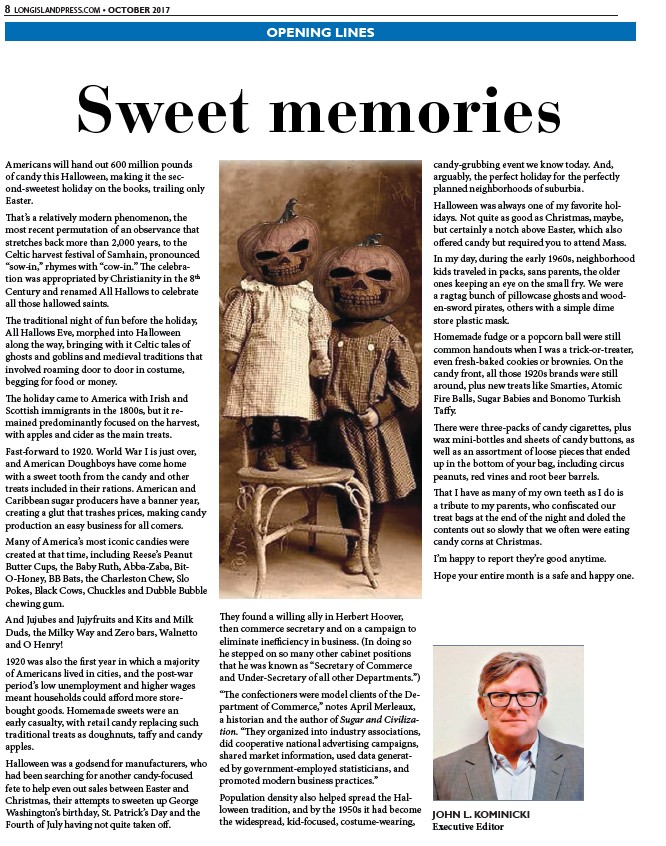
8 LONGISLANDPRESS.COM • OCTOBER 2017 8 LONGISLANDPRESS.COM • SEPTEMBER 2017 8 LONGISLANDPRESS.CO M • SEPTEMBER 201-----------TUTU111
Americans will hand out 600 million pounds
of candy this Halloween, making it the second
sweetest holiday on the books, trailing only
Easter.
That’s a relatively modern phenomenon, the
most recent permutation of an observance that
stretches back more than 2,000 years, to the
Celtic harvest festival of Samhain, pronounced
“sow-in,” rhymes with “cow-in.” The celebration
was appropriated by Christianity in the 8th
Century and renamed All Hallows to celebrate
all those hallowed saints.
The traditional night of fun before the holiday,
All Hallows Eve, morphed into Halloween
along the way, bringing with it Celtic tales of
ghosts and goblins and medieval traditions that
involved roaming door to door in costume,
begging for food or money.
The holiday came to America with Irish and
Scottish immigrants in the 1800s, but it remained
predominantly focused on the harvest,
with apples and cider as the main treats.
Fast-forward to 1920. World War I is just over,
and American Doughboys have come home
with a sweet tooth from the candy and other
treats included in their rations. American and
Caribbean sugar producers have a banner year,
creating a glut that trashes prices, making candy
production an easy business for all comers.
Many of America’s most iconic candies were
created at that time, including Reese’s Peanut
Butter Cups, the Baby Ruth, Abba-Zaba, Bit-
O-Honey, BB Bats, the Charleston Chew, Slo
Pokes, Black Cows, Chuckles and Dubble Bubble
chewing gum.
And Jujubes and Jujyfruits and Kits and Milk
Duds, the Milky Way and Zero bars, Walnetto
and O Henry!
1920 was also the first year in which a majority
of Americans lived in cities, and the post-war
period’s low unemployment and higher wages
meant households could afford more storebought
goods. Homemade sweets were an
early casualty, with retail candy replacing such
traditional treats as doughnuts, taffy and candy
apples.
Halloween was a godsend for manufacturers, who
had been searching for another candy-focused
fete to help even out sales between Easter and
Christmas, their attempts to sweeten up George
Washington’s birthday, St. Patrick’s Day and the
Fourth of July having not quite taken off.
They found a willing ally in Herbert Hoover,
then commerce secretary and on a campaign to
eliminate inefficiency in business. (In doing so
he stepped on so many other cabinet positions
that he was known as “Secretary of Commerce
and Under-Secretary of all other Departments.”)
“The confectioners were model clients of the Department
of Commerce,” notes April Merleaux,
a historian and the author of Sugar and Civilization.
“They organized into industry associations,
did cooperative national advertising campaigns,
shared market information, used data generated
by government-employed statisticians, and
promoted modern business practices.”
Population density also helped spread the Halloween
tradition, and by the 1950s it had become
the widespread, kid-focused, costume-wearing,
candy-grubbing event we know today. And,
arguably, the perfect holiday for the perfectly
planned neighborhoods of suburbia.
Halloween was always one of my favorite holidays.
Not quite as good as Christmas, maybe,
but certainly a notch above Easter, which also
offered candy but required you to attend Mass.
In my day, during the early 1960s, neighborhood
kids traveled in packs, sans parents, the older
ones keeping an eye on the small fry. We were
a ragtag bunch of pillowcase ghosts and wooden
sword pirates, others with a simple dime
store plastic mask.
Homemade fudge or a popcorn ball were still
common handouts when I was a trick-or-treater,
even fresh-baked cookies or brownies. On the
candy front, all those 1920s brands were still
around, plus new treats like Smarties, Atomic
Fire Balls, Sugar Babies and Bonomo Turkish
Taffy.
There were three-packs of candy cigarettes, plus
wax mini-bottles and sheets of candy buttons, as
well as an assortment of loose pieces that ended
up in the bottom of your bag, including circus
peanuts, red vines and root beer barrels.
That I have as many of my own teeth as I do is
a tribute to my parents, who confiscated our
treat bags at the end of the night and doled the
contents out so slowly that we often were eating
candy corns at Christmas.
I’m happy to report they’re good anytime.
Hope your entire month is a safe and happy one.
OPENING LINES
Sweet memories
JOHN L. KOMINICKI
Executive Editor